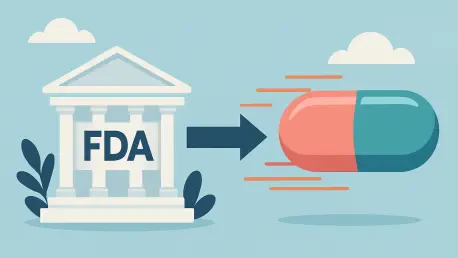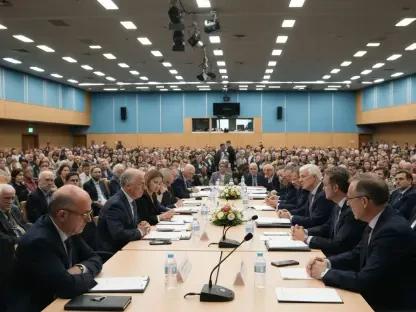The pharmaceutical landscape is on the brink of a seismic shift with the introduction of the FDA’s Commissioner’s National Priority Voucher (CNPV) pilot program, a bold initiative designed to cut the review timeline for drug and biological product applications from the standard 10-12 months down to an astonishing 1-2 months. Championed by FDA Commissioner Marty Makary as a practical solution to deliver faster cures, the program employs a unique “tumor board style” discussion to expedite decisions. Yet, this dramatic acceleration has ignited a firestorm of debate among industry stakeholders, public health advocates, and regulatory experts. While the promise of quicker access to life-saving treatments is undeniably appealing, especially in the face of urgent medical crises, the potential risks to safety and scientific rigor cannot be ignored. As this ambitious plan rolls out, the central question emerges: can the FDA achieve a delicate balance between speed and the stringent safety standards that have long defined its mission? This article delves into the heart of the controversy, examining the program’s potential benefits, the serious concerns it raises, and the systemic challenges that could determine its success or failure.
The Promise of Accelerated Access
The CNPV program represents a transformative approach to drug approvals, aiming to slash review times to just 1-2 months for therapies deemed critical to national health priorities. This initiative targets pressing issues like affordability, domestic manufacturing, and unmet medical needs, offering a lifeline in scenarios such as pandemics or rare disease outbreaks where every day counts. Supporters argue that such rapid access could fundamentally alter outcomes for patients who might otherwise face long waits for innovative treatments. By prioritizing therapies of significant public interest, the program seeks to address gaps that traditional review processes often struggle to fill, potentially saving countless lives in times of crisis. However, the question of whether the FDA’s infrastructure and methodologies can support this unprecedented pace without sacrificing quality remains a lingering concern for many observers.
Beyond the immediate appeal of speed, the CNPV program introduces a novel framework for identifying and fast-tracking drugs through discretionary awards determined by the FDA Commissioner. Unlike the existing Priority Review Voucher (PRV) system, which focuses on specific categories like rare diseases, this initiative casts a wider net to encompass broader national interests. This flexibility could allow the FDA to respond dynamically to emerging health threats or policy goals. Yet, the compressed timeline raises doubts about the depth of evaluation possible within such a short window. As the program seeks to revolutionize how therapies reach the market, it must contend with the reality that scientific scrutiny often requires time—a resource now in critically short supply under this new model.
Safety Under Scrutiny
One of the most significant criticisms of the CNPV program centers on the potential erosion of safety standards due to its drastically reduced review timeline. Critics, including prominent groups like Doctors for America, warn that compressing the evaluation process into 1-2 months risks overlooking subtle but critical safety signals in new drugs or biologics. Historical instances of rushed approvals resulting in post-market safety issues serve as a cautionary backdrop to these concerns. The absence of input from advisory committees, which traditionally provide independent and nuanced perspectives on complex therapies, further amplifies fears that important risks could slip through the cracks. While the FDA maintains that safety remains paramount, the lack of detailed mechanisms to ensure thorough analysis under such tight constraints fuels skepticism among experts and patient advocates alike.
Adding to the unease is the inherent challenge of conducting comprehensive scientific reviews within the CNPV’s aggressive timeframe. Evaluating the full spectrum of clinical data, from efficacy to long-term side effects, typically demands months of meticulous analysis—a process that seems nearly impossible to condense without compromise. Public health experts argue that even a single oversight could have devastating consequences, not only for patients but also for the FDA’s credibility as a guardian of drug safety. The program’s safeguard of extending timelines for incomplete submissions offers some reassurance, but it does little to address the systemic risk of prioritizing speed over depth. As debates continue, the tension between urgent access and unwavering safety standards remains a defining issue for this initiative.
Resource Challenges and Operational Feasibility
The CNPV program places considerable strain on the FDA’s already stretched resources, raising questions about the agency’s capacity to manage such rapid reviews alongside its existing commitments. Unlike programs supported by the Prescription Drug User Fee Act (PDUFA), which provide dedicated funding through user fees, this initiative lacks a specific financial mechanism to offset its demands. Industry analysts caution that diverting staff and resources to meet the 1-2-month timeline could disrupt other critical review processes, potentially delaying approvals for drugs outside the CNPV scope. This ripple effect might harm patients awaiting treatments not deemed national priorities, creating an unintended hierarchy of access that could undermine the FDA’s broader mission to serve public health equitably.
Operationally, the program introduces a host of logistical hurdles that further complicate its feasibility. Coordinating pre-approval inspections, reviewing complex chemistry and manufacturing data, and ensuring compliance within such a tight window appears daunting, even under optimal conditions. Experts highlight that the FDA already struggles to meet certain PDUFA performance goals due to staffing and funding constraints, and the added burden of CNPV reviews could exacerbate these delays. Without a strategic plan to allocate resources or streamline workflows, the agency risks falling short on both accelerated and standard approvals. The operational challenges underscore a broader need for sustainable support structures to ensure that speed does not come at the expense of the FDA’s fundamental responsibilities.
Sponsor Preparedness and Industry Impact
The CNPV program not only tests the FDA’s capabilities but also places immense pressure on drug sponsors to adapt to its rigorous demands. Companies must submit near-flawless applications from the outset, as the compressed timeline leaves virtually no room for iterative feedback or corrections once the review begins. Larger pharmaceutical firms with established digital infrastructure and cross-functional governance may be well-positioned to navigate these challenges, leveraging robust systems to ensure compliance. However, smaller biotech companies, often at the forefront of innovative therapies, may find themselves at a disadvantage, lacking the resources to meet such stringent requirements. This disparity raises concerns about whether the program inadvertently favors industry giants over emerging players, potentially stifling diversity in drug development.
Further complicating the landscape is the issue of transparency and fairness in the CNPV award process. The discretionary nature of voucher distribution, based on criteria that remain somewhat ambiguous, sparks fears of bias or political influence in decision-making. Unlike the PRV program, which offers transferable vouchers with clear guidelines and significant financial value, the CNPV’s non-transferable nature and limited usage window diminish its appeal as an incentive, particularly for early-stage firms. This structure may fail to motivate smaller companies to invest in therapies aligned with national priorities, limiting the program’s overall impact. As sponsors grapple with these organizational and strategic challenges, the uneven playing field could shape the future of pharmaceutical innovation in unexpected ways.
Weighing the Trade-Offs for Future Success
Looking back, the rollout of the CNPV pilot program sparked a critical examination of how regulatory bodies could adapt to urgent health needs while upholding their duty to protect patients. The initiative’s ambitious goal of slashing review times to 1-2 months was met with both hope and apprehension, as stakeholders grappled with the inherent trade-offs between speed and safety. The intense debates that unfolded revealed a shared understanding that while faster access to therapies was vital, it could not come at the cost of rigorous scientific evaluation. Concerns over resource strain, operational hurdles, and industry disparities underscored the complexity of implementing such a transformative policy within an already burdened system.
Moving forward, the legacy of this program hinged on actionable steps to address its challenges. Strengthening safety protocols through enhanced post-market surveillance and reintroducing external advisory input emerged as key priorities to rebuild trust. Allocating dedicated funding and staff to support accelerated reviews without disrupting other processes was also critical to operational success. Additionally, refining the criteria for CNPV awards to ensure transparency and equity could broaden its appeal across the industry. These measures, if implemented effectively, offered a pathway to harmonize the dual imperatives of speed and safety, ensuring that future iterations of such programs served the public good without compromising integrity.









